Avaya B179 User Manual

Avaya B179 SIP Conference Phone
Installation and Administration Guide
16-603915 Issue 4
December 2011

Avaya B179 SIP Conference Phone |
Installation and Administration Guide |
ABOUT THIS DOCUMENT
© 2011 Avaya Inc.
All Rights Reserved.
Notice
While reasonable efforts have been made to ensure that the information in this document is complete and accurate at the time of printing, Avaya assumes no liability for any errors. Avaya reserves the right to make changes and corrections to the information in this document without the obligation to notify any person or organization of such changes.
Documentation disclaimer
Avaya shall not be responsible for any modifications, additions, or deletions to the original published version of this documentation unless such modifications, additions, or deletions were performed by Avaya. End User agree to indemnify and hold harmless Avaya, Avaya’s agents, servants and employees against all claims, lawsuits, demands and judgments arising out of, or in connection with, subsequent modifications, additions or deletions to this documentation, to the extent made by End User.
Link disclaimer
Avaya is not responsible for the contents or reliability of any linked Web sites referenced within this site or documentation(s) provided by Avaya. Avaya is not responsible for the accuracy of any information, statement or content provided on these sites and does not necessarily endorse the products, services, or information described or offered within them. Avaya does not guarantee that these links will work all the time and has no control over the availability of the linked pages.
Warranty
Avaya provides a limited warranty on this product. Refer to your sales agreement to establish the terms of the limited warranty. In addition, Avaya’s standard warranty language, as well as information regarding support for this product, while under warranty, is available to Avaya customers and other parties through the Avaya Support Web site: http:/www.avaya.com/support. Please note that if you acquired the product from an authorized Avaya reseller outside of the United States and Canada, the warranty is provided to you by said Avaya reseller and not by Avaya.
Licenses
THE SOFTWARE LICENSE TERMS AVAILABLE ON THE AVAYA WEBSITE, HTTP://SUPPORT.AVAYA.COM/ LICENSEINFO/ ARE APPLICABLE TO ANYONE WHO DOWNLOADS, USES AND/OR INSTALLS AVAYA SOFTWARE, PURCHASED FROM AVAYA INC., ANY AVAYA AFFILIATE, OR AN AUTHORIZED AVAYA RESELLER (AS APPLICABLE) UNDER A COMMERCIAL AGREEMENT WITH AVAYA OR AN AUTHORIZED AVAYA RESELLER. UNLESS OTHERWISE AGREED TO BY AVAYA IN WRITING, AVAYA DOES NOT EXTEND THIS LICENSE IF THE SOFTWARE WAS OBTAINED FROM ANYONE OTHER THAN AVAYA, AN AVAYA AFFILIATE OR AN AVAYA AUTHORIZED RESELLER, AND AVAYA RESERVES THE RIGHT TO TAKE LEGAL ACTION AGAINST YOU AND ANYONE ELSE USING OR SELLING THE SOFTWARE WITHOUT A LICENSE. BY INSTALLING, DOWNLOADING OR USING THE SOFTWARE, OR AUTHORIZING OTHERS TO DO SO, YOU, ON BEHALF
OF YOURSELF AND THE ENTITY FOR WHOM YOU ARE INSTALLING, DOWNLOADING OR USING THE SOFTWARE (HEREINAFTER REFERRED TO INTERCHANGEABLY AS “YOU” AND “END USER”), AGREE TO THESE TERMS AND CONDITIONS AND CREATE A BINDING CONTRACT BETWEEN YOU AND AVAYA INC. OR THE APPLICABLE AVAYA AFFILIATE (“AVAYA”).
Avaya grants End User a license within the scope of the license types described below. The applicable number of licenses and units of capacity for which the license is granted will be one (1), unless a different number
of licenses or units of capacity is specified in the Documentation or other materials available to End User. “Designated Processor” means a single stand-alone computing device. “Server” means a Designated Processor that hosts a software application to be accessed by multiple users. “Software” means the computer programs in object code, originally licensed by Avaya and ultimately utilized by End User, whether as stand-alone products or pre-installed on Hardware. “Hardware” means the standard hardware originally sold by Avaya and ultimately utilized by End User.
License types
Concurrent User License (CU). End User may install and use the Software on multiple Designated Processors or one or more Servers, so long as only the licensed number of Units are accessing and using the Software
2

Avaya B179 SIP Conference Phone |
Installation and Administration Guide |
ABOUT THIS DOCUMENT
at any given time. A “Unit” means the unit on which Avaya, at its sole discretion, bases the pricing of its licenses and can be, without limitation, an agent, port or user, an e-mail or voice mail account in the name of a person or corporate function (e.g., webmaster or helpdesk), or a directory entry in the administrative database utilized by the Software that permits one user to interface with the Software. Units may be linked to a specific, identified Server. CPU License (CP). End User may install and use each copy of the Software on a number of Servers up to the number indicated by Avaya provided that the performance capacity of the Server(s) does not exceed the performance capacity specified for the Software. End User may not re-install or operate the Software on Server(s) with a larger performance capacity without Avaya’s prior consent and payment of an upgrade fee
Copyright
Except where expressly stated otherwise, no use should be made of materials on this site, the Documentation(s) and Product(s) provided by Avaya. All content on this site, the documentation(s) and the product(s) provided by Avaya including the selection, arrangement and design of the content is owned either by Avaya or its licensors and is protected by copyright and other intellectual property laws including the
sui generis rights relating to the protection of databases. You may not modify, copy, reproduce, republish, upload, post, transmit or distribute in any way any content, in whole or in part, including any code and software. Unauthorized reproduction, transmission, dissemination, storage, and or use without the express written consent of Avaya can be a criminal, as well as a civil, offense under the applicable law.
Third-party components
Certain software programs or portions thereof included in the Product may contain software distributed under third party agreements (“Third Party Components”), which may contain terms that expand or limit rights to use certain portions of the Product (“Third Party Terms”). Information regarding distributed Linux OS source code (for those Products that have distributed the Linux OS source code), and identifying the copyright holders of the Third Party Components and the Third Party Terms that apply to them is available on the Avaya Support Web site: http://www.avaya.com/support/Copyright/.
Preventing toll fraud
“Toll fraud” is the unauthorized use of your telecommunications system by an unauthorized party (for example, a person who is not a corporate employee, agent, subcontractor, or is not working on your company’s behalf). Be aware that there can be a risk of toll fraud associated with your system and that, if toll fraud occurs, it can result in substantial additional charges for your telecommunications services.
Avaya fraud intervention
If you suspect that you are being victimized by toll fraud and you need technical assistance or support, call Technical Service Center Toll Fraud Intervention Hotline at +1-800-643-2353 for the United States and Canada. For additional support telephone numbers, see the Avaya Support Web site: http://www.avaya.com/ support/. Suspected security vulnerabilities with Avaya products should be reported to Avaya by sending mail to: securityalerts@avaya.com.
Trademarks
The trademarks, logos and service marks (“Marks”) displayed in this site, the documentation(s) and product(s) provided by Avaya are the parties. Users are not permitted to use such Marks without prior written consent from Avaya or such third party which may own the Mark. Nothing contained in this site, the documentation(s) and product(s) should be construed as granting, by implication, estoppel, or otherwise, any license or right in and to the Marks without the express written permission of Avaya or the applicable third party. Avaya is a registered trademark of Avaya Inc. All other trademarks are the property of their respective owners.
Downloading documents
For the most current versions of documentation, see the Avaya Support Web site: http://www.avaya.com/ support
Contact Avaya Support
Avaya provides a telephone number for you to use to report problems or to ask questions about your product. The support telephone number is 1-800-242-2121 in the United States. For additional support telephone numbers, see the Avaya Web site: http://www.avaya.com/support
3

Avaya B179 SIP Conference Phone |
Installation and Administration Guide |
ABOUT THIS DOCUMENT
This document only includes setup, registration of accounts and configuration. The use of the conference phone is described in the Avaya B179 SIP Conference Phone - Quick Reference Guide (16-603916) and the Avaya B179 SIP Conference Phone - User Guide
(16-603918). The latest version of all documentation can be downloaded from support. avaya.com.
Please note that there are also supporting Application Notes describing the steps to configure the Avaya B179 SIP Conference Phone to work with certain systems and also how to configure the systems (eg. administer SIP extensions).
4

Avaya B179 SIP Conference Phone |
Installation and Administration Guide |
|
CONTENT |
Description |
2 |
Display information and web interface |
3 |
Display screen................................................................ |
3 |
Navigation and selection in menus.................................... |
4 |
Using the web interface................................................... |
6 |
Installation |
7 |
Connecting..................................................................... |
7 |
Obtaining a network address ........................................... |
8 |
Login............................................................................. |
8 |
Software upgrade and basic settings................................. |
9 |
Registering an account.................................................. |
12 |
Settings |
14 |
Login........................................................................... |
14 |
Basic........................................................................... |
14 |
SIP.............................................................................. |
17 |
Network....................................................................... |
23 |
Media.......................................................................... |
26 |
LDAP........................................................................... |
29 |
Web interface............................................................... |
31 |
Time & Region.............................................................. |
32 |
Provisioning.................................................................. |
33 |
System......................................................................... |
34 |
Headset and PA installation and settings |
35 |
Connecting a wireless headset........................................ |
35 |
Connecting a PA interface box........................................ |
36 |
PA settings................................................................... |
37 |
Hard system recovery |
39 |
Provisioning – upgrade and configuration |
40 |
Firmware upgrade on a single phone............................... |
40 |
Using a configuration file............................................... |
42 |
Using a device management server................................. |
48 |
Managing phone book and conference guide |
52 |
Importing and exporting contacts.................................... |
52 |
Importing and exporting conference groups...................... |
54 |
Checking status and logs |
55 |
Device.......................................................................... |
55 |
Network....................................................................... |
55 |
Time & Region.............................................................. |
56 |
SIP.............................................................................. |
56 |
Media.......................................................................... |
57 |
Log.............................................................................. |
58 |
Technical data |
60 |
1

Avaya B179 SIP Conference Phone |
|
|
Installation and Administration Guide |
||
DESCRIPTION |
|
|
|
|
|
Speaker |
Microphone |
Display screen |
Keypad |
LEDs |
|
|
|
|
|
Flashing blue |
Incoming call |
|
|
|
|
Steady blue light |
Call in progress |
|
|
|
|
Flashing red |
On hold, |
|
|
|
|
|
microphone and |
|
|
|
|
|
speakers turned |
|
|
|
|
|
off |
|
|
|
|
Steady red light |
Mute, |
|
|
|
|
|
microphone turned |
|
|
|
|
|
off |
|
|
|
Network cable port |
|
|
|
|
|
|
SD memory card port |
|
|
|
|
|
|
Expansion |
|
|
|
|
|
microphone |
|
|
|
|
|
port |
|
|
|
|
|
AUX port |
Maintenance |
|
|
|
Security lock port |
|
Clean the equipment with |
|
|
|
||
|
|
|
|
||
a soft, dry cloth. Never use |
|
|
|
|
|
liquids. |
|
|
|
|
|
|
|
|
|
Power supply port |
|
|
|
|
|
Expansion microphone port |
|
|
UP ARROW |
|
Menu |
DOWN ARROW |
|
|
Navigation in menus |
|
Settings |
Navigation in menus |
|
|
Display of call list |
|
|
Display of call list |
|
|
Cancel |
|
|
OK |
|
No/end/back |
|
|
Yes/confirm choice |
||
Start/stop |
|
|
Answer/connect new line |
||
recording |
|
|
|||
|
|
During a call: Press to call |
|||
Increase volume |
|
|
|||
|
|
a new person |
|||
Decrease volume |
|
|
Hang up/end line |
||
|
|
|
|
||
|
Mute |
|
|
Conference |
|
|
|
|
Automatic dialling of |
||
|
|
|
|
conference groups |
|
|
|
|
|
One press of this button |
|
|
|
|
|
will always connect all par- |
|
|
Hold |
Alphanumerical buttons |
ties to a conference call |
||
|
|
|
|||
|
Hold down a button for 2 seconds |
|
|
||
|
|
Line selection |
|||
|
|
to open the phonebook |
|||
|
|
|
|
||
Some Avaya B179 have a different keypad with other symbols. This does not affect the functions of the buttons.
2
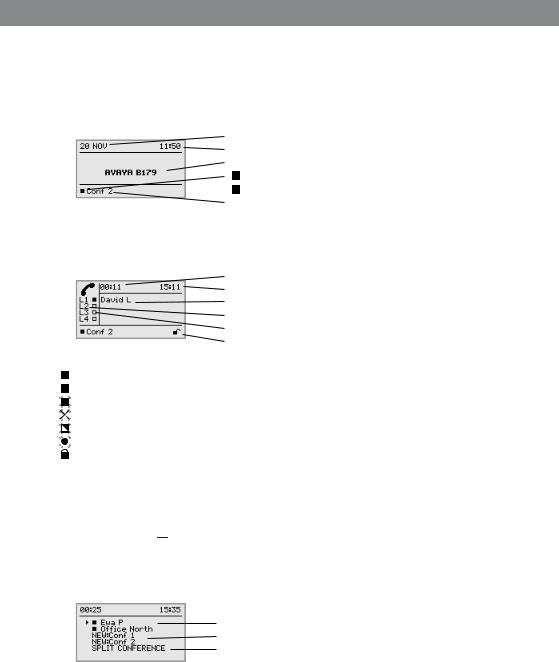
Avaya B179 SIP Conference Phone |
Installation and Administration Guide |
DISPLAY INFORMATION AND WEB INTERFACE
DISPLAY SCREEN
On Hook
Press  to display this screen.
to display this screen.
Date
Time
Display text (can be changed)
Registered
Not registered
Account name (can be changed)
Off Hook
Press  to display this screen.
to display this screen.
Call duration
Time
Information text (see below)
Phone lines (L1–L4)
Line status (see below)
Secure connection (see page 10)
Line status:
Line free (Before account name – telephone not registered)
Line connected (Before account name – telephone registered)
Line on hold (“HOLD” displayed on the screen – all calls on hold)
Line (called party) busy
Own line put on hold by other party
Recording call
Secure connection
Information text displays one of the following:
•Number or name of each phone line
(The name will be displayed if a number is in the phone book)
•Explanation of what you should do (For example ENTER NUMBER)
•Status (For example  when you place all calls on hold)
when you place all calls on hold)
Line menu
Press  to switch to and from this menu.
to switch to and from this menu.
Line/number/name
New line (two lines if two accounts are registered)
Option for creating or splitting conference calls
3
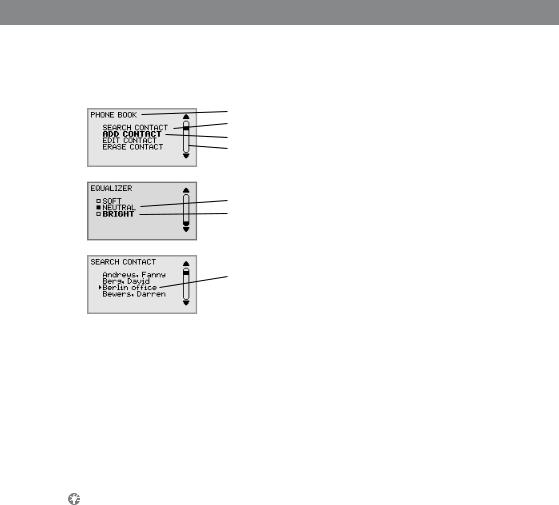
Avaya B179 SIP Conference Phone |
Installation and Administration Guide |
DISPLAY INFORMATION AND WEB INTERFACE
Menu
Press  to switch to and from a menu.
to switch to and from a menu.
Current menu Submenu
Marked option – open by pressing OK button
Scrolling list
(indication of where the marked option is in the list or menu)
List of setting options:
Existing settings
Marked option – select by pressing OK button
List of names:
Marked name – select by pressing OK button
NAVIGATION AND SELECTION IN MENUS
Press  .
.
Select the option you want from the menu using the arrow buttons.
Confirm by pressing OK to select the marked option.
Cancel the setting or go back one level in the menu by pressing 
 .
.
Quit the menu by pressing  again.
again.
Note that after you have made changes to a setting, you must press OK to activate the setting.
It is possible to open a menu option directly by pressing the number button that corresponds to the position of the option in the menu (e.g. 2 to open PHONE BOOK and then 3 to select EDIT CONTACT).
Writing style in instructions
In the instructions,  > SETTINGS (6) means you should:
> SETTINGS (6) means you should:
Press  .
.
Mark the SETTINGS option using the arrow buttons and confirm by pressing OK to open the menu (or press button number 6).
Correspondingly, Phone book > Conference Guide in the web interface means you should select Menu Phone book and the Conference Guide tab.
4
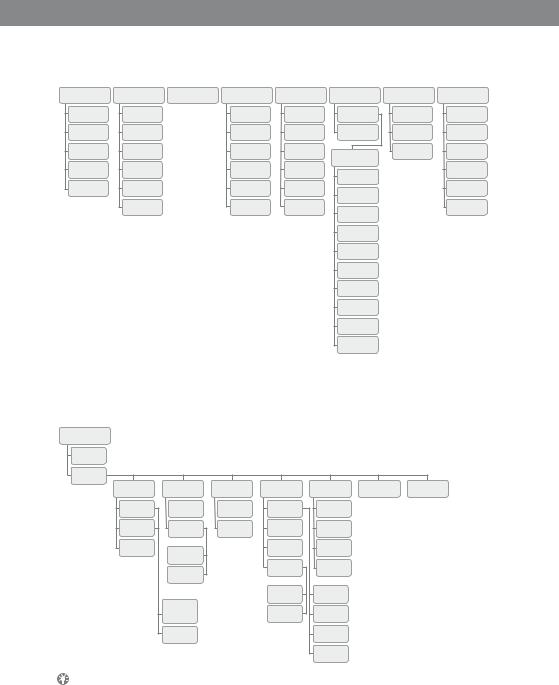
Avaya B179 SIP Conference Phone |
|
|
|
Installation and Administration Guide |
|||
|
DISPLAY INFORMATION AND WEB INTERFACE |
||||||
Menu tree |
|
|
|
|
|
|
|
1 |
2 |
3 |
4 |
5 |
6 |
7 |
8 |
PROFILES |
PHONE BOOK |
EXT. PHONE BOOK |
CONF GUIDE |
RECORDING |
SETTINGS |
SYSTEM |
STATUS |
DEFAULT |
SEARCH |
|
SEARCH |
PLAYBACK |
BASIC |
RESTART |
ACCOUNTS |
|
CONTACT |
|
GROUP |
FILE |
|
|
|
PROFILE 1 |
ADD |
|
ADD |
RENAME |
ADVANCED |
REBOOT |
NETWORK |
|
CONTACT |
|
GROUP |
FILE |
|
|
|
PROFILE 2 |
EDIT |
|
EDIT |
ERASE |
BASIC |
FACTORY |
NAT |
|
CONTACT |
|
GROUP |
FILE |
RESET |
TRAVERSAL |
|
PROFILE 3 |
ERASE |
|
ERASE |
ERASE |
SETTINGS |
|
MEDIA |
|
|
|
|||||
|
CONTACT |
|
GROUP |
ALL |
ACCOUNTS |
|
|
PROFILE 4 |
ERASE |
|
ERASE |
SETTINGS |
|
|
TIME |
|
ALL |
|
ALL |
|
LANGUAGE |
|
|
|
STATUS |
|
STATUS |
STATUS |
|
|
DEVICE |
|
|
|
|
|
KEY TONE |
|
|
|
|
|
|
|
RING LEVEL |
|
|
|
|
|
|
|
EQUALIZER |
|
|
|
|
|
|
|
AUX PORT |
|
|
|
|
|
|
|
PA |
|
|
|
|
|
|
|
TIME |
|
|
|
|
|
|
|
FORMAT |
|
|
|
|
|
|
|
SCREEN |
|
|
|
|
|
|
|
TEXT |
|
|
|
|
|
|
|
DEFAULT |
|
|
Menu tree, advanced settings
The advanced settings are protected by administrator’s PIN code. The default value is 1234.
SETTINGS
BASIC
ADVANCED PIN
ACCOUNTS |
NETWORK |
NAT |
MEDIA |
TIME |
REGION |
WEB |
|
|
TRAVERSAL |
|
|
|
INTERFACE |
ACCOUNT 1 |
IP |
STUN |
CODEC |
NTP |
|
|
ACCOUNT 2 |
ETHERNET |
OFFER ICE |
VAD |
TIME DATE |
|
|
TRANSPORT |
|
|
DTMF |
TIME ZONE |
|
|
|
VLAN |
|
SIGNALLING |
|
|
|
|
|
|
SECURITY |
DAYLIGHT |
|
|
|
802.1X |
|
|
SAVING |
|
|
|
AUTH |
|
|
|
|
|
|
|
|
SRTP |
G722 |
|
|
|
ENABLE/ |
|
|
PCMA |
|
|
|
DISABLE |
|
SIGNALLING |
|
|
|
|
ACCOUNT |
|
|
|
|
|
|
EDIT |
|
|
PCMU |
|
|
|
ACCOUNT |
|
|
|
|
|
|
|
|
|
G729 |
|
|
The simplest way to make settings and edit contacts is using a PC and the Avaya B179 web interface.
5

Avaya B179 SIP Conference Phone |
Installation and Administration Guide |
DISPLAY INFORMATION AND WEB INTERFACE
USING THE WEB INTERFACE
You can use the web browser of a PC connected to the same network to manage contacts, conference groups and settings in the Avaya B179.
For security reasons, recordings can only be managed directly on the Avaya B179. All other settings that can be made directly on the Avaya B179 can also be made via the web interface. It is also possible to import and export contacts and conference groups, name user profiles and change PIN codes, which can only be done via the web interface. The administrator can also view logs, update software and create a configuration file.
The default setting for the PIN code is 0000 for the user account (Default, Profile 1, Profile 2, Profile 3 and Profile 4) and 1234 for the administrator’s account (Admin). We recommend that you change the PIN codes in order to protect the settings. The code may consist of eight digits. The administrator can always view and change the PIN codes to the user accounts. The administrator’s PIN code can only be reset with a complete reset to factory settings.
Checking IP address
Press  and select the sub menu STATUS > NETWORK (8,2).
and select the sub menu STATUS > NETWORK (8,2).
Check the conference phone’s network address under the heading IP ADDRESS.
Use this address to log into the web server in the conference phone.
Login
Log into the web server in Avaya B179 by entering the phone’s network address in your computer’s web browser.
Select Admin as Profile and enter your PIN.
6
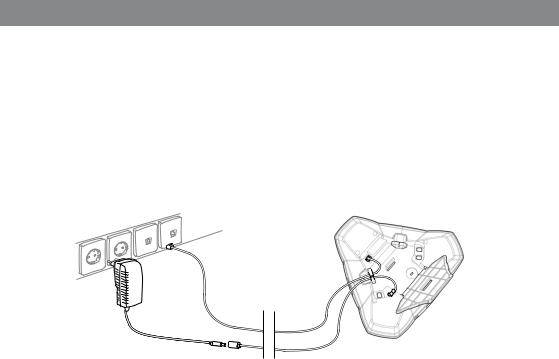
Avaya B179 SIP Conference Phone |
Installation and Administration Guide |
INSTALLATION
The printed Installation Guide provides brief and simplified installation instructions. The guide includes the basic settings for a quick start and works in most cases.
CONNECTING
Connect the Avaya B179 to the network as illustrated below.
Plug the Avaya B179 into the mains using the power adapter as illustrated below.
The Avaya B179 can be driven directly from the network (Power over Ethernet) if the network supports this.
Place the conference phone in the middle of the table.
The Avaya B179 must obtain a network address and be registered in a SIP PBX before it can be used. The easiest way to register an account and make the settings in the Avaya B179 is using a computer connected to the same network and via the integrated web server.
7

Avaya B179 SIP Conference Phone |
Installation and Administration Guide |
INSTALLATION
OBTAINING A NETWORK ADDRESS
Connecting to a network with DHCP
See “Check IP address” under “USING THE WEB INTERFACE” on page 6.
Connecting to a network with static IP addresses
You need the IP address, host name, domain, netmask, gateway, DNS 1, and DNS 2. The host name can be set freely. The domain and secondary DNS can be left blank.
Press  and select SETTINGS > ADVANCED (6,2). Enter the PIN code.
and select SETTINGS > ADVANCED (6,2). Enter the PIN code.
The default code is 1234. Select NETWORK (2)
Select STATIC IP.
Enter values for the IP ADDRESS.
Enter three digits (begin with 0 if necessary), press OK, enter three digits, and so on.
Enter HOST NAME
Default is avaya.
Enter DOMAIN
Enter NETMASK
Enter GATEWAY Enter DNS 1 Enter DNS 2
The display shows DONE.
LOGIN
See “Login” under “USING THE WEB INTERFACE” on page 6.
8

Avaya B179 SIP Conference Phone |
Installation and Administration Guide |
INSTALLATION
SOFTWARE UPGRADE AND BASIC SETTINGS
The following settings should be done during installation.
See page 48 about Device management if you are responsible for installing or upgrading many phones.
Note that all settings on the Basic tab also affect the user profile Default. Other user profiles can be changed individually. The settings on the Basic tab, except the name and PIN for Admin, can be modified by any user. Other settings require a login as Admin.
Upgrade software
See the heading “PROVISIONING – UPGRADE AND CONFIGURATION” on page 40 for a detailed description and upgrading options.
Select Settings > Provisioning.
Click on Check Now.
Compare the latest version with the current version (shown on the web page).
If you want to upgrade, select the desired version in the list box and click on
Upgrade.
The browser window and the display on the Avaya B179 shows that the upgrade has begun.
The download and installation can take several minutes. Do not interrupt the upgrade and do not disconnect plugs to the Avaya B179 during the upgrade. Interrupting the upgrade may render the conference phone inoperable.
When installation is complete, the text “Upgrade Complete. The unit will be rebooted.” is shown in your browser, and after a while you hear the Avaya music signature, which indicates that the conference phone has started.
9

Avaya B179 SIP Conference Phone |
Installation and Administration Guide |
INSTALLATION
Setting time and region
Select Settings > Time & Region.
Select the time zone and, if you wish, correction for DST (Daylight saving).
It is also possible to set the time and date manually or choose a different time server.
Select the region where you are.This setting affects the signalling. Save the setting.
The Avaya B179 reboots with the new settings.
10
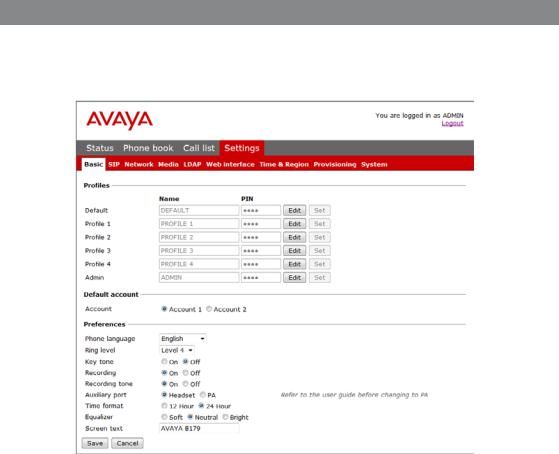
Avaya B179 SIP Conference Phone |
Installation and Administration Guide |
INSTALLATION
Changing the language
Select Settings > Basic.
Select the desired language in the list box after Language and save the setting.
Changing the PIN
We recommend that you change the PIN code for Admin from the default setting to protect the settings. Make a note of the new PIN code and keep it in a safe place. The administrator’s PIN code can only be reset by a full factory reset!
Select Settings > Basic and click the Edit button on the Admin line.
Enter a new PIN.
The PIN code may consist of 8 digits. Click on the Set and Save buttons.
11
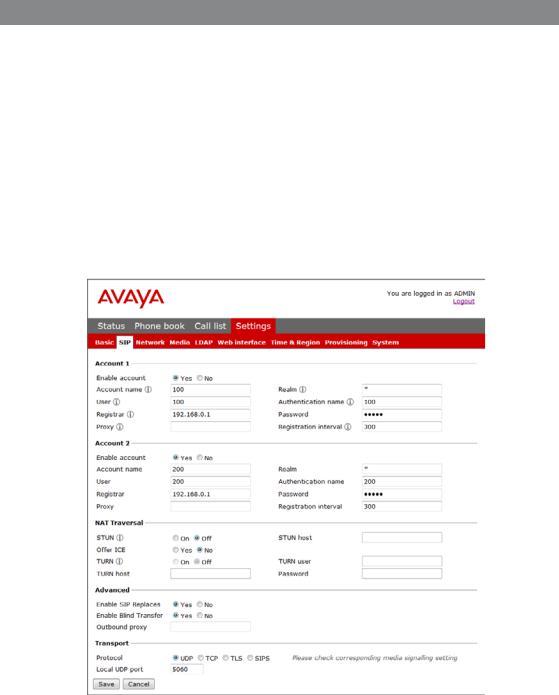
Avaya B179 SIP Conference Phone |
Installation and Administration Guide |
INSTALLATION
REGISTERING AN ACCOUNT
The conference phone can be registered in a company SIP PBX or with a public IP telephony service provider. You can store settings for two accounts in the Avaya B179. To register your phone, you must have access to the account information and all necessary settings that the SIP PBX or service provider requires.
See the heading “SIP” on page 17 for a detailed description of all settings.
Select Settings > SIP.
Click Yes at Enable account under Account 1. Enter the account information you have received.
Account name can be chosen freely and is the name or phone number you want to appear in the phone display.
Leave the default values if you have no other information.
12

Avaya B179 SIP Conference Phone |
Installation and Administration Guide |
INSTALLATION
Select a method of NAT traversal if you have received this information.
Select a different transport protocol if you have received this information. See page 20 about using a secure transport protocol.
Save the settings by clicking the Save button.
The Avaya B179 responds by showing REGISTERING. If registration is successful, your selected account name will appear at the bottom of the display screen next to a shaded square.
Make media settings
Select a different codec priority, if you do not accept the default settings. See page 26.
Select a SRTP option if you need a secure media protocol. See page 27. Note that this also requires a corresponding transport setting on the SIP tab.
13

Avaya B179 SIP Conference Phone |
Installation and Administration Guide |
SETTINGS
Almost all settings can be done directly on the Avaya B179. See “NAVIGATION AND SELECTION IN MENUS” on page 4 for using the menu system. We explain how to make settings using the web interface as this is the easiest method.
For safety reasons, recordings can only be managed directly on the Avaya B179. All other settings can be changed via the web interface. The web interface also allows you to import and export contacts and conference groups, rename user profiles and change PIN codes. As an administrator, you can also study logs, upgrade the software and create an XML based configuration file for easier management of a set of phones.
LOGIN
See “USING THE WEB INTERFACE” on page 6 for a description of how to log in to the web server in the Avaya B179.
BASIC
Select Settings > Basic.
14

Avaya B179 SIP Conference Phone |
Installation and Administration Guide |
SETTINGS
These settings affect the Admin and Default profiles. To change the basic settings of a user profile, you need to log in with that profile.
Profiles – edit name and PIN
We recommend that you change the PIN code from the default setting to protect the settings.
Select Settings > Basic and click the Edit button on the account you want to change.
Enter a new PIN code.
The PIN code may consist of 8 digits.
You can also choose to change the name of a user profile. Click on the Set and Save buttons.
Make a note of the new PIN code and keep it in a safe place.
The administrator’s PIN code can only be reset with a complete reset to factory settings!
Default account
This setting determines which account will be used as default. By pressing  before dialling a number, you can choose the alternative account for the call.
before dialling a number, you can choose the alternative account for the call.
Select Account 1 or Account 2 and click on the Save button.
On phone:  > SETTINGS > BASIC > ACCOUNT (6,1,1).
> SETTINGS > BASIC > ACCOUNT (6,1,1).
Language
Select language using the list box and click on the Save button.
On phone:  > SETTINGS > BASIC > LANGUAGE (6,1,2).
> SETTINGS > BASIC > LANGUAGE (6,1,2).
Ring level
There are six volume levels plus a silent mode. You will hear the ring tone for each level you select. If you select silent mode, only the blue LEDs on the phone flash when an incoming call is received.
Select level using the list box and click on the Save button.
On phone:  > SETTINGS > BASIC > RING LEVEL (6,1,4).
> SETTINGS > BASIC > RING LEVEL (6,1,4).
Key tone
You can select whether or not you want a tone to be heard when you press a button. Select On or Off and click on the Save button.
On phone:  > SETTINGS > BASIC > KEY TONE (6,1,3).
> SETTINGS > BASIC > KEY TONE (6,1,3).
15

Avaya B179 SIP Conference Phone |
Installation and Administration Guide |
SETTINGS
Recording
It is possible to turn off the recording feature. This setting can only be done by the administrator and affects all profiles.
Select On or Off and click on the Save button.
Recording tone
A short beep is heard every 20 seconds so that all the parties in the call know it is being recorded. This feature can be turned off.
Select On or Off and click on the Save button.
On phone:  > RECORDING TONE > SETTINGS (5,5).
> RECORDING TONE > SETTINGS (5,5).
Settings when connecting external equipment (Aux)
The Avaya B179 can be connected to a wireless headset or an external PA system. An optional PA interface box is required for PA system connection.
Select the PA option to activate features for external microphone mixer and PA system.
Do not select the PA option unless a PA system is connected. This option turns off the internal microphone and internal speakers as default. The HEADSET option may be selected whether or not a headset is connected.
Time format
Select 12 hour or 24 hour and click on the Save button.
On phone:  > SETTINGS > BASIC > TIME FORMAT (6,1,7).
> SETTINGS > BASIC > TIME FORMAT (6,1,7).
Equalizer
The sound reproduction can be adjusted to the required pitch (SOFT, NEUTRAL or BRIGHT).
Select Soft, Neutral or Bright and click on the Save button.
On phone:  > SETTINGS > BASIC > EQUALIZER (6,1,5).
> SETTINGS > BASIC > EQUALIZER (6,1,5).
Screen text
The text on the display screen is shown when the Avaya B179 is in stand-by mode (on hook).
Enter your new text in the text box and click on the Save button.
On phone:  > SETTINGS > BASIC > SCREEN TEXT (6,1,8).
> SETTINGS > BASIC > SCREEN TEXT (6,1,8).
16
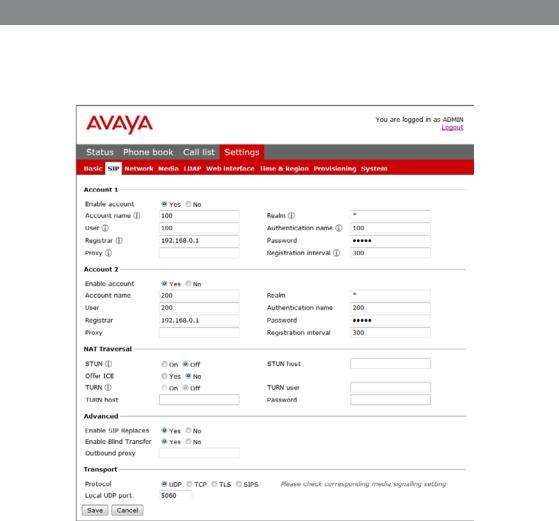
Avaya B179 SIP Conference Phone |
Installation and Administration Guide |
SETTINGS
SIP
Select Settings > SIP
The Avaya B179 can store information for two accounts, e.g. one PBX and one public service provider.
Why use two accounts?
It may be sensible to register a second account if the PBX or SIP server is located in another country than the phone. Otherwise, local calls using the PSTN (telephone network), connected through the ordinary PBX or SIP server, would be connected as international calls.
17
